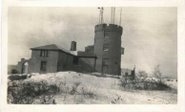Winter '12 / '13 - Stratospheric Sudden Warming: Watch #1
 UPDATE2: Earlier suggestions of a fizzled SSW event appears to have fizzled. No long lasting effects are expected from this short-lived event; however...the PV did reverse course as forecast.
UPDATE2: Earlier suggestions of a fizzled SSW event appears to have fizzled. No long lasting effects are expected from this short-lived event; however...the PV did reverse course as forecast. Warm colors shown on the stage-right image from the Japan Meteorological Agency (JMA) depict easterly wind flow. East winds over the Pole means an anti-cyclone has replaced the normal cyclonic circulation associated with the PV.
---
UPDATE: Earlier suggestions of a SSW event appears to have fizzled.
Forecasts of a split PV @100 mb peaks during the next day or two followed by a return to a single vortex center and a return to deep-layer cyclonic flow over the Pole.
---
The ECMWF continues to depict a sudden stratospheric warming event during late November into early December.
The polar vortex (PV) is forecast to begin splitting in two at 100 mb early next week with distinct centers of circulation over Victoria Island...CN and south-central Russia by 03-DEC.
The effects would be felt at the surface in about three weeks if this feature develops as forecast.
Deep layer easterlies are also progged over high latitudes by D+10 indicating the presence of an Arctic anticyclone.
The QBO is in the waning stage of its easterly cycle such that the PV is already in a 'weakened' state. Major winter stratospheric warmings preferentially occur during the easterly phase of the QBO. Holton and Tan (1980)
The QBO determines the character of the early winter, leading to a colder and more stable polar vortex in December and January during the west phase of the QBO and a more disturbed and warmer Arctic during the east phase of the QBO.(1)
From Thompson et. al...
Pronounced weakenings of the NH wintertime stratospheric polar vortex tend to be followed by episodes of anomalously low surface air temperatures and increased frequency of occurrence of extreme cold events throughout densely populated regions such as eastern North America, northern Europe, and eastern Asia that persist for ~2 months.(2)The Arctic Oscillation (AO) is heading for a cliff. The GFS forecast takes the AO on a deep dive where it remains negative through D+10.

























No comments:
Post a Comment